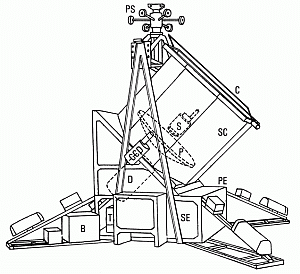Purpose of the flight and payload description
The main objective of the instrument is to make observations of the Cosmic Microwaves Background anisotropies.
The heart of the ARGO 1989 experiment is a Cassegrian Telescope, the primary mirror has a diameter of 120 cm and was built in alluminium alloy for a total weight of 35 Kg.
The secondary mirror is also in aluminum alloy and can be wobbled with an amplitude of 4º with respect to the optical axis.
Radiation collected from the telescope is then, splited in 3 cryogenic bolometric detectors.
The telescope is completed by a large thermal radiation shield made using an aluminium skeleton supporting a 10 cm thick glass wool insulation covered with several foils of aluminized mylar. The overall instrument is mounted on a stabilized gondola.
Besides that scientific objetive, this flight was used also to test many subsystems wich will compose the future TIR telescope, for this reason this experiment was also called Mini-TIR.
In this flight all the systems performed perfectly and valuable scientific data was obtained from the observation of the infrared diffuse emission from the Galactic dust at high Galactic latitudes.
Details of the balloon flight
Balloon launched on: 8/9/1989 at 22:45 local
Launch site: Base di Lancio Luigi Broglio, Trapani, Sicily, Italy
Balloon launched by: Centre National d'Etudes Spatiales (CNES)
Balloon manufacturer/size/composition: Zero Pressure Balloon model 603z Zodiac - 600.000 m3
End of flight (L for landing time, W for last contact, otherwise termination time): 8/10/1989
Balloon flight duration (F: time at float only, otherwise total flight time in d:days / h:hours or m:minutes - ): 22 h 51 m
Landing site: In El Bosque, near Jerez de la Frontera, Spain
Campaign: ODISSEA 89
Payload weight: 2487 kgs
The balloon was launched at 22.45 local time on August 9, 1989 by dynamic method using a crane as launch vehicle.
The balloon headed due west fliying over the Mediterranean towards Spain. The flight duration was of 22 hours and 51 minutes.
The payload was cutdown over Spain at 36,53º N - 5,53º O, and landed by parachute, in El Bosque, near the city of Jerez de la Frontera.
The balloon landed west of Montellano (Sevilla), in the cortijo �El Bollo�.
External references
- A balloon-borne study of diffuse far IR backgrounds Società Astronomica Italiana, Memorie, vol. 61, no. 1, 1990, p. 231
- A millimeter and submillimeter balloon telescope for measurements of diffuse radiation ESA, From Ground-Based to Space-Borne Sub-mm Astronomy p 335-340
- A short-wavelength measurement of the cosmic background radiation anisotropy Astrophysical Journal, Part 2 - Letters vol. 360, Sept. 10, 1990, p. L31-L34
- ARGO: a balloon-borne telescope for measurements of the millimeter diffuse sky emission Astronomy and Astrophysics, Vol. 271, p. 683 (1993)
- Les activites balloons en France 88-89 CNES brochure (1990)
- The ARGO project: Scientific targets, first results and future perspectives Il Nuovo Cimento C 15, 993-1011 (1992)
2069If you consider this website interesting or useful, you can help me to keep it up and running with a small donation to cover the operational costs. Just the equivalent of the price of a cup of coffee helps a lot.


